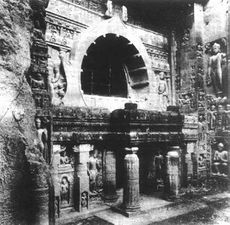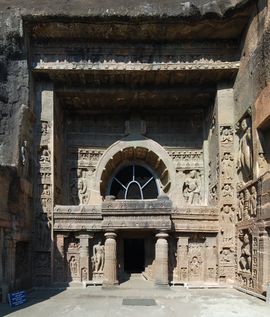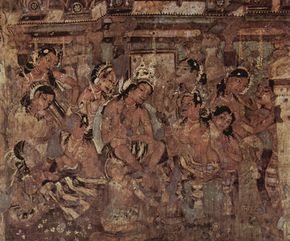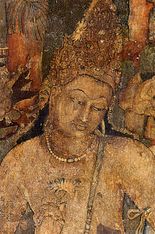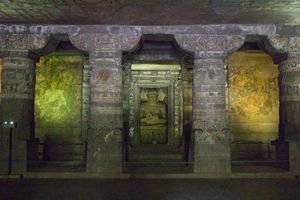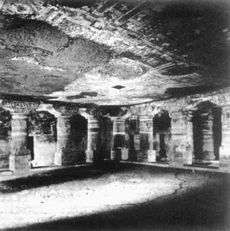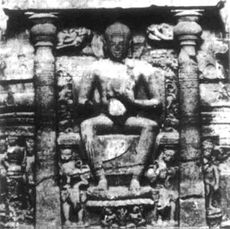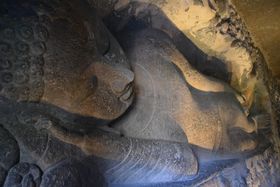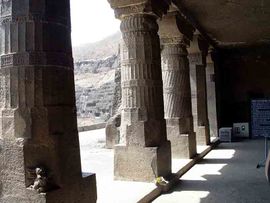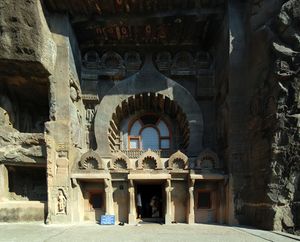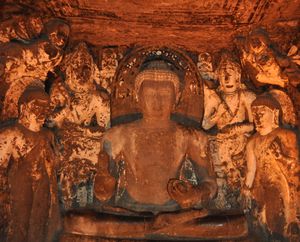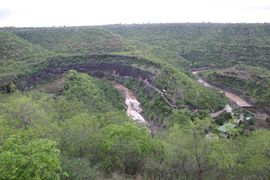كهوف أجانتا
| كهوف أجانتا Ajanta Caves | |
|---|---|
 | |
| أسس الاختيار | ثقافي: i, ii, iii, vi |
| المراجع | 242 |
| Inscription | 1983 (السابع Session) |
| Coordinates | 20°33′12″N 75°42′01″E / 20.55333°N 75.70028°E |
كهوف أجانتا Ajanta، هي قرية أثرية في منطقة حيدرأباد قرب بومباي، الهند. وتشتهر بكهوف البوذيين التي كان يسكنها رهبان البوذية. وموقع القرية كان قرب طريق القوافل التجارية الكبري بغربي شبه القارة الهندية. وأقدم هذه الكهوف يرجع الي سنة 2000 ق.م. وعليها صور جدارية ملونة بالداخل . فلقد بطنت الجدران بروث البهائم وبطنت بالجص. وبعد الجفاف تم تلوينها ورسمها برسوم دينية ودنيوية.
تقع كهوف آجانتا الشهيرة في إقليم الدكن، بمنطقة حيدر آباد من الهند وتبعد نحو 105 كم عن مدينة أورنگ أباد في ولاية مهاراشترا في أواسط الهند وغربيها. وقد ظهرت في هذا الموقع نهضة فنية استمرت نحو خمسة قرون ونيف بين القرنين الأول والسابع بعد الميلاد، وبرزت هذه النهضة في ثلاثين كهفاً ضخماً محفورة في الصخور وتبدو مصطفة في أعلى وادي نهر الغانج في ما يشبه مدينة دينية. وتتميز هذه الكهوف باحتواء معظمها على لوحات جدارية مهمة تزين جدرانها وتعبّر عن نبض روحي وحسٍ جمالي ومهارة فائقة في التنفيذ.
ويحتل فن آجانتا مكانة مهمة في تاريخ الفن الهندي، وهو يعبر عن الصفاء والحب الروحي في بيئة رأت (أن ممارسة الفن نشاط مبارك ومن مصدر إلهي).
التاريخ
كهوف الفترة الأولى (ساتاڤاهانا)
الكهوف الفترة التالية (ڤاكاتاكا)
اعادة الاكتشاف
اللوحات
ويلاحظ في تصاوير آجانتا تجمع موفق وثابت ينبض بالحياة بأشخاص في لقاءات ومشاهد غرامية ومواقف مأساوية، وهو تجمع خفي يرصد البطولة ومظاهرها وتبدو الأوضاع فيه كأنها سكبت في أبيات من الشعر، ويبدو المشهد كأنه يروى في قصة، وتكفي خطوة الشخص للدلالة على تغير المكان. فالتجمع مرن، ولكنه مدروس ومتوازن، ولا ينطوي الانتقال من حيّز إلى آخر، في هذه الأعمال، على أي مفاجأة. وإذا كان الانطباع الأول يوحي بأن تجمع الأشخاص جاء عفوياً، إلا أنه سرعان ما تدرك العين نظاماً فنياً في تكوين المشاهد وارتباط بعضها ببعض وخضوعها لإيقاع واضح يتحقق معه الانسجام والتوازن، ويتم التمركز في اللوحات من خلال الشخصيات الثانوية التي تحيط بالتكوين وهي منحنية لتقود البصر نحو الشخصيات الرئيسية.
والخلاصة فإن ما يغلب على المشاهد المصورة في آجانتا أنها مستوحاة من قصص بوذية وقد تمثلت فيها بيئة تظهر فيها حياة الدين الخيالية ويتجلى فيها الانسجام مع الرقة والنعومة مما يذكر بفخامة مسرح الحبّ السنسكريتي.
النسخ
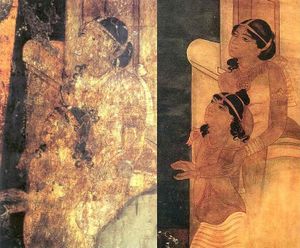
Section of the mural in Cave 17, the 'coming of Sinhala'. The prince (Prince Vijaya) is seen in both groups of elephants and riders.
The consecration of King Sinhala, Prince Vijaya, detail from Cave 17.
العمارة
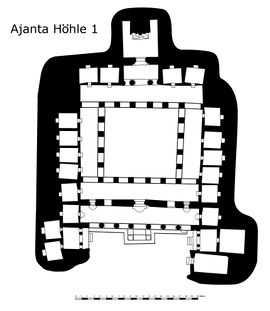
تدل منحوتات كهوف آجانتا على مدى تطور فن النحت في عهد أسرة گوپتا (مابين القرنين الرابع والسادس بعد الميلاد) ويتضح ذلك من تماثيل بوذا ويبدو متدثراً بثوبه، وتظهر عيناه مغمضتين وحاجباه على شكل قوسين مخططين بوضوح وشفتاه مقوستين. وتبرز التماثيل صفات أخرى جاءت من الفن الإغريقي - البوذي، وانصهرت في عبقرية الهند التي أبدعت فناً أكثر توازناً وصفاءً ورقة وحيوية. هنا يظهر بوذا (560-480 ق.م.) ملتفاً بثوب يبدو كأنه من قماش «الموسلين» وقد ابتل بالماء فتموجت ثنياته. أما في بداية عصر گوپتا فقد اختفت الثنيات وبدا الثوب مصقولاً شفافاً يغطي جسم بوذا بكامله. وهناك نوعان من تماثيل بوذا: تماثيل يبدو فيها واقفاً تنسدل ملابسه الفضفاضة لتؤكد الوقار والاتزان، وتماثيل في جلسة ملكية وحول رأسه هالة من نور. [1]
وفي جميع الأحوال يبدو بوذا طويل القامة ويوحي بالرقة. إلا أن المثَّالين اتجهوا، بعد عصر گوپتا، وفي القرنين السابع والثامن بعد الميلاد، نحو التعبير عن قوة الإنسان العلوي فظهرت نماذج تمثل بوذا بجسم وأطراف ثقيلة ضخمة.
وقد اشتهرت كهوف آجانتا بتصاويرها الجدارية الرائعة التي تبرز المعاني الإنسانية وفيها تجسيد حياة بوذا. غير أنه لم يبق من الأعمال التي سبقت عصر گوپتا سوى بعض الآثار في الكهف التاسع. وفي الكهف العاشر يوجد إفريز طويل يتميز بحيوية نادرة ويمثل مشاهد فيلة بين نباتات اللوتس ومحاربين وراقصات. أما القسم الأكبر من التصاوير فيعود إلى حقبة متأخرة ترجع إلى عهد أسرة گوپتا وتتجلى في الكهوف ذات الأرقام 17،16،2،1 وقد اتبعت في تنفيذها طريقة تشبه الجصيات.
والفن في أجانتا فن مثالي لا يبحث عن التعبير المباشر أو الإيحاء بالواقع بطريق النور والظل لأنه يطمح إلى هدف أعمق وأبعد غوراً، مستخدماً تعابير الوجوه والحركات للدلالة على مضامين روحية وجمالية. إن الصور التي تمثل الـ «بوديستافا» (نظراء بوذا) تتميز بالعظمة والتوازن في هدوء لا تشوبه شائبة. ففي صدر الكهف الأول صورة رجلين من «البوديستافا» يحيطان بالبناء النموذجي للعمارة البوذية «داگوپا» ويؤكدان في انحنائهما التوازن، وتعبر ملامح وجهيهما عن الصفار والحزن الناجمين عن الإعياء.
تتعدد الطرز الفنية في كهوف آجانتا وتمثل اختلافاً بين المدارس الفنية متطوراً مع الزمن. ولعلَّ أهم هذه الطرز ما يشاهد في الكهفين الأول والثاني، وفي بعض التفصيلات في الكهف السادس عشر، مما يتميز بالضخامة وحسن معالجة الظلال والأضواء، والثقل في قماش الملابس، والوجوه ذات الفم الضيّق الكثيف، وأقواس الحواجب المحددة بخط مستمر.
Cave 9, an early chaitya hall, with murals surviving, and plain octagonal columns
Stupa with standing Buddha in Cave 19
أيقونية الكهوف
الكهوف
تأريخ سپينك المفصل
انظر أيضاً
الهوامش
- ^ بشير زهدي. "آجانتا". الموسوعة العربية. Retrieved 2014-05-04.
المصادر
- "ASI": Archaeological Survey of India website, with a concise entry on the Caves, accessed 20 October 2012
- Cohen, Richard S. Beyond Enlightenment: Buddhism, Religion Modernity. (Oxford and New York: Routledge, 2006)
- Gordon, Sophie (2011), Monumental visions: architectural photography in India, 1840–1901, PhD thesis, SOAS, University of London, PDF available
- Harle, J.C., The Art and Architecture of the Indian Subcontinent, 2nd edn. 1994, Yale University Press Pelican History of Art, ISBN 0300062176
- Michell, George, The Penguin Guide to the Monuments of India, Volume 1: Buddhist, Jain, Hindu, 1989, Penguin Books, ISBN 0140081445
- Singh, Rajesh K. An Introduction to the Ajanta Caves (Baroda: Hari Sena Press, 2012). ISBN 978-81-925107-0-5
- Spink, Walter M. (2006). Ajanta: History and Development Volume 5: Cave by Cave. Leiden: Brill. ISBN 90-04-15644-5.
{{cite book}}: Invalid|ref=harv(help) - Spink, Walter M. (2008), Ajanta Lecture: Korea May 2008 (revised September 2008)
- Spink, Walter M. (2009). Ajanta: History and Development Volume 4: Painting, Sculpture, Architecture, Year by Year. Leiden: Brill. ISBN 90-04-14983-X.
{{cite book}}: Invalid|ref=harv(help)
قراءات إضافية
| الحج إلى الأماكن المقدسة البوذية |

|
| الأماكن الأربعة المقدسة الرئيسية |
|---|
| لومبيني · Bodh Gaya Sarnath · كوشينگر |
| الأماكن الأربعة الإضافية |
| Sravasti · راجگير سانكيسا · ڤايشالي |
| أماكن أخرى |
| پاتاليپوترا · گايا · كوسامبي Kapilavastu · Devadaha Kesariya · پاڤا نالندا · ڤرناسي |
| مواقع لاحقة |
| Sanchi · متهرا إلورا · أجانتا · Vikramshila راتناگيري · أوداياگيري · لاليتگيري بهارهوت · كهوف بارابار |
- Burgess, James and Fergusson J. Cave Temples of India. (London: W.H. Allen & Co., 1880. Delhi: Munshiram Manoharlal Publishers Pvt Ltd., Delhi, 2005). ISBN 81-215-0251-9
- Burgess, James, and Indraji, Bhagwanlal. Inscriptions from the Cave Temples of Western India, Archaeological Survey of Western India, Memoirs, 10 (Bombay: Government Central Press, 1881).
- Burgess, James. Buddhist Cave Temples and Their Inscriptions, Archaeological Survey of Western India, 4 (London: Trubner & Co., 1883; Varanasi: Indological Book House, 1964).
- Burgess, James. “Notes on the Bauddha Rock Temples of Ajanta, Their Paintings and Sculptures,” Archaeological Survey of Western India, 9 (Bombay: Government Central Press, 1879).
- Behl, Benoy K. The Ajanta Caves (London: Thames & Hudson, 1998. New York: Harry N. Abrams, 1998).
- Cohen, Richard S. “Ajanta’s Inscriptions.” In Walter M. Spink, Ajanta: History And Development, volume 2: Arguments About Ajanta (Leiden: E.J. Brill, 2006), pp. 273–339.
- Cohen, Richard S. “Nāga, Yaksinī, Buddha: Local Deities and Local Buddhism at Ajanta,” History of Religions. 37/4 (May 1998): 360–400.
- Cohen, Richard S. “Problems in the Writing of Ajanta’s History: The Epigraphic Evidence,” Indo-Iranian Journal. 40/2 (April 1997): 125–48.
- Cohen, Richard Scott. Setting the Three Jewels: The Complex Culture of Buddhism at the Ajanta Caves. A Ph.D. dissertation (Asian Languages and Cultures: Buddhist Studies, University of Michigan, 1995).
- Cowell, E.B. The Jataka, I-VI (Cambridge: Cambridge, 1895; reprint, 1907).
- Dhavalikar, M.K. Late Hinayana Caves of Western India (Pune: 1984).
- Griffiths, J. Paintings in the Buddhist Cave Temples of Ajanta, 2 vols. (London: 1896 – 1897).
- Halder, Asit Kumar. "AJANTA" Edited and annotated by Prasenjit Dasgupta and Soumen Paul, with a Foreword by Gautam Halder LALMATI. Kolkata. 2009
- Kramrisch, Stella. A Survey of Painting in the Deccan (Calcutta and London: The India Society in co-operation with the Dept. of Archaeology, 1937). Reproduced: “Ajanta,” Exploring India’s Sacred Art: Selected Writings of Stella Kramrisch, ed. Miller, Barbara Stoler (Philadelphia: University of Pennsylvania Press: 1983), pp. 273–307; reprint (New Delhi: Indira Gandhi National Centre for the Arts, 1994), pp. 273–307.
- Majumdar, R.C. and A.S. Altekar, eds. The Vakataka-Gupta Age. New History of Indian People Series, VI (Benares: Motilal Banarasidass, 1946; reprint, Delhi: 1960).
- Mirashi, V.V. “Historical Evidence in Dandin’s Dasakumaracharita,” Annals of the Bhandarkar Oriental Research Institute, 24 (1945), 20ff. Reproduced: Studies in Indology, 1 (Nagpur: Vidarbha Samshodhan Mandal, 1960), pp. 164–77.
- Mirashi, V.V. Inscription of the Vakatakas. Corpus Inscriptionum Indicarum Series, 5 (Ootacamund: Government Epigraphist for India, 1963).
- Mirashi, V.V. The Ghatotkacha Cave Inscriptions with a Note on Ghatotkacha Cave Temples by Srinivasachar, P. (Hyderabad: Archaeological Department, 1952).
- Mirashi, V.V. Vakataka inscription in Cave XVI at Ajanta. Hyderabad Archaeological Series, 14 (Calcutta: Baptist mission Press for the Archaeological Department of His Highness the Nizam’s Dominions, 1941).
- Mitra, Debala. Ajanta, 8th ed. (Delhi: Archaeological Survey of India, 1980).
- Nagaraju, S. Buddhist Architecture of Western India (Delhi: 1981).
- Parimoo, Ratan; et al. The Art of Ajanta: New Perspectives, 2 vols (New Delhi: Books & Books, 1991).
- Schlingloff, Dieter. Guide to the Ajanta Paintings, vol. 1; Narrative Wall Paintings (Delhi: Munshiram Manoharlal Publishers Pvt. Ltd., 1999)
- Schlingloff, Dieter. Studies in the Ajanta Paintings: Identifications and Interpretations (New Delhi: 1987).
- Shastri, Ajay Mitra, ed. The Age of the Vakatakas (New Delhi: Harman, 1992).
- Singh, Rajesh Kumar. ‘The Early Development of the Cave 26-Complex at Ajanta,’ South Asian Studies (London: March 2012), vol. 28, No. 1, pp. 37–68.
- Singh, Rajesh Kumar. ‘Buddhabhadra’s Dedicatory Inscription at Ajanta: A Review,’ in Pratnakirti: Recent Studies in Indian Epigraphy, History, Archaeology, and Art, 2 vols, Professor Shrinivas S. Ritti Felicitation volume, ed. by Shriniwas V. Padigar and Shivanand V (Delhi: Agam Kala Prakashan, 2012), vol. 1, pp. 34–46.
- Singh, Rajesh Kumar, et al. Ajanta: Digital Encyclopaedia [CD-Rom] (New Delhi: Indira Gandhi National Centre for Arts, 2005).
- Singh, Rajesh Kumar. “Enumerating the Sailagrhas of Ajanta,” Journal of the Asiatic Society of Mumbai 82, 2009: 122–26.
- Singh, Rajesh Kumar. “Ajanta: Cave 8 Revisited,” Jnana-Pravah Research Journal 12, 2009: 68–80.
- Singh, Rajesh Kumar. “Some Problems in Fixing the Date of Ajanta Caves,” Kala, the Journal of Indian Art History Congress 17, 2008: 69–85.
- Sister Nivedita. "The Ancient Abbey of Ajanta" Edited and annotated by Prasenjit Dasgupta and Soumen Paul, with a Foreword by Dr Gautam Sengupta. LALMATI. Kolkata. 2009.
- Spink, Walter M. (2009). Ajanta: History and Development Volume 4: Painting, Sculpture, Architecture, Year by Year. Leiden: Brill. ISBN 90-04-14983-X.
{{cite book}}: Invalid|ref=harv(help) - Spink, Walter M. “A Reconstruction of Events related to the development of Vakataka caves,” C.S. Sivaramamurti felicitation volume, ed. M.S. Nagaraja Rao (New Delhi: 1987).
- Spink, Walter M. “Ajanta’s Chronology: Cave 1’s Patronage,” Chhavi 2, ed. Krishna, Anand (Benares: Bharat Kala Bhawan, 1981), pp. 144–57.
- Spink, Walter M. “Ajanta’s Chronology: Cave 7’s Twice-born Buddha,” Studies in Buddhist Art of South Asia, ed. Narain, A.K. (New Delhi: 1985), pp. 103–16.
- Spink, Walter M. “Ajanta’s Chronology: Politics and Patronage,” Kaladarsana, ed. Williams, Joanna (New Delhi: 1981), pp. 109–26.
- Spink, Walter M. “Ajanta’s Chronology: The Crucial Cave,” Ars Orientalis, 10 (1975), pp. 143–169.
- Spink, Walter M. “Ajanta’s Chronology: The Problem of Cave 11,” Ars Orientalis, 7 (1968), pp. 155–168.
- Spink, Walter M. “Ajanta’s Paintings: A Checklist for their Dating,” Dimensions of Indian Art, Pupul Jayakar Felicitation Volume, ed. Chandra, Lokesh; and Jain, Jyotindra (Delhi: Agam Kala Prakashan, 1987), p. 457.
- Spink, Walter M. “Notes on Buddha Images,” The Art of Ajanta: New Perspectives, vol. 2, ed. Parimoo, Ratan, et al. (New Delhi: Books & Books, 1991), pp. 213–41.
- Spink, Walter M. “The Achievement of Ajanta,” The Age of the Vakatakas, ed. Shastri, Ajaya Mitra (New Delhi: Harman Publishing House, 1992), pp. 177–202.
- Spink, Walter M. “The Vakataka’s Flowering and Fall,” The Art of Ajanta: New Perspectives, vol. 2, ed. Parimoo, Ratan, et al. (New Delhi: Books & Books, 1991), pp. 71–99.
- Spink, Walter M. “The Archaeology of Ajanta,” Ars Orientalis, 21, pp. 67–94.
- Weiner, Sheila L. Ajanta: It’s Place in Buddhist Art (Berkeley and Los Angeles: University of California Press, 1977).
- Yazdani, Gulam. Ajanta: the Colour and Monochrome Reproductions of the Ajanta Frescoes Based on Photography, 4 vols. (London: Oxford University Press, 1930 [31?], 1955).
- Yazdani, Gulam. The Early History of the Deccan, Parts 7–9 (Oxford: 1960).
- Zin, Monika. Guide to the Ajanta Paintings, vol. 2; Devotional and Ornamental Paintings (Delhi: Munshiram Manoharlal Publishers Pvt. Ltd., 2003)
وصلات خارجية
- An Introduction to the Ajanta Caves
- The Early Development of the Cave 26-Complex at Ajanta
- Ajanta Caves
- National Geographic feature 'Faces of the Divine'
- An essay on Ajanta Caves from the online travel magazine travelmag.co.uk (10 May 2009)
- Video of the caves MTDC site
- Ajanta Caves in UNESCO List
- "Ajanta", Jacques-Edouard Berger Foundation, World Art Treasures (choose French or English)
- Ajanta Caves Pictures
- Frontline Article On Ajanta Paintings
- Article on Ajanta from the Travel section of the New York Times (5 November 2006)
- Photographs
- Video Travelogue on Ajanta Cave Temples
- Ajanta Caves – rock cut Buddhist temples | Wondermondo
- 360 degree virtual tour of Ajanta caves
- Ajanta: Written in the Stone. Documentary by Laurence Castle based on Walter Spink's finding.
- Ajanta: Some Kind of Miracle. Documentary by Laurence Castle, the history of Ajanta.
- Pages using gadget WikiMiniAtlas
- Coordinates on Wikidata
- Pages using infobox UNESCO World Heritage Site with unknown parameters
- Aurangabad, Maharashtra
- عمارة هندية
- فن هندي
- رسم هندي
- فن وثقافة بوذية
- معالم سياحية في مهاراشترا
- تاريخ مهاراشترا
- أماكن حج بوذية
- كهوف مهاراشترا
- مواقع التراث العالمي في الهند
- أماكن حج تضم كهوف في الهند
- أماكن مأهولة سابقة في الهند
- Aurangabad district, Maharashtra
- Indian rock-cut architecture
- كهوف بوذية


